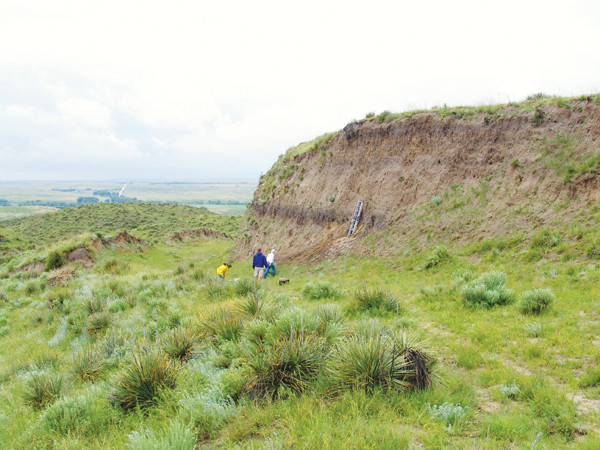
by Allison Mills Tuesday, September 2, 2014

Erosion on the U.S. Great Plains reveals a buried, carbon-rich layer of fossil soil. Researchers recently found that buried fossil soils contain significant amounts of black carbon. Credit: Joseph Mason.
The so-called Brady soil — a dark horizon up to a meter thick that underlies much of Kansas and Nebraska — is widespread but often unseen. The layer is a paleosol, or fossil soil, that formed about 15,500 to 13,500 years ago when the region was a stable grassland built atop dunes of thick, wind-blown loess. That changed when the Laurentide Ice Sheet retreated and dunes swallowed the grasslands.
The Brady soil was buried quickly, and because of that, parts of it host large swaths of carbon, according to a new study published in Nature Geoscience. Currently, global carbon inventories do not account for carbon stored in buried soils because, unlike carbon at the soil surface, fossil soils are considered disconnected from the atmosphere and the greater carbon cycle. However, human activities could quickly unearth this carbon.
The carbon in some buried soils is preserved and “doesn’t decompose very quickly,” says lead author Erika Marin-Spiotta, a geographer at the University of Wisconsin at Madison. And it might stay that way unless it’s brought to the surface, she says. For the Brady soil, its unique history has affected its carbon chemistry.
To characterize the paleosol’s carbon, Marin-Spiotta and her team ran multiple isotopic and spectroscopic tests on soil samples collected in southwest Nebraska. Analyzing the stable carbon isotopes, they verified past studies that documented a shift from one type of grass to another, indicating a warming climate. These changes are believed to have spurred soil development across a broad region, followed by burial of the Brady soil as dunes took over the warming landscape. But what the researchers were really interested in was a component of the soil: A fine, dark dust in the aggregates that contained a surprising amount of black carbon, a product of fire.
Some black carbon was expected, but the team found much more than was previously thought to be in the soil, Marin-Spiotta says. “This is a new story in that there was just so much fire during this particular time period,” she says, explaining that more black carbon suggests more widespread fire. The story plays out with a domino effect: Persistent fire combined with rapid warming at the end of the ice age led to vegetation loss and reactivation of dunes. That, in turn, led “to the rapid burial and this long-term persistence of deep carbon,” Marin-Spiotta says. Past studies used flotation techniques to identify charcoal, which underestimate black carbon content; in this study, the team used thermal and chemical analyses to identify it.
Black carbon is relatively stable and made of hard-to-break aromatic rings, she says, but it’s far from inert. Previous research has shown how microbes and ultraviolet radiation can break it down. At the researchers’ study site in Nebraska, the Brady soil is buried under 6 meters of loess, meaning it’s unlikely it will have any interaction with the atmosphere.
“This isn’t dead soil, dead carbon in these buried horizons — [the carbon] could indeed react with the atmosphere if re-exposed,” says Bill Johnson, a professor of geography at the University of Kansas who wrote an accompanying commentary in the same issue of Nature Geoscience. The study is the “first demonstration that this is black carbon, largely undecomposed, that, when exposed, behaves like a modern, present soil surface,” he says.
Johnson says he marvels at “just the sheer geography of it.” The Brady soil and its equivalents are spread far across the Midwest, stretching from North Dakota to Colorado to Missouri. Not all of these buried soils are as isolated as the site studied by the Marin-Spiotta team; there are places where the Brady soil mixes with modern soils, where it has been exposed to the atmosphere and the carbon is actively cycling. But much of the Brady soil — and fossil soils across the world — remain disconnected.
“I think we’re majorly underestimating the amount of carbon in buried soils,” Marin-Spiotta says, especially given that most climate models assume deep carbon is unreactive and safely stored away. “But just because it’s old doesn’t mean microbes can’t break it down,” she says, particularly if human activities like mining, construction and agriculture bring paleosols to the surface quicker than natural erosion rates.
Marin-Spiotta says the next step is finding out more about the carbon in other buried soils. And there are a lot to look at — under loess like the Brady soil, in alluvial floodplains, under lava flows, under landslides and under human-modified landscapes. Looking at these other buried soils will help answer questions about the reactivity of the carbon stored in them.
© 2008-2021. All rights reserved. Any copying, redistribution or retransmission of any of the contents of this service without the expressed written permission of the American Geosciences Institute is expressly prohibited. Click here for all copyright requests.